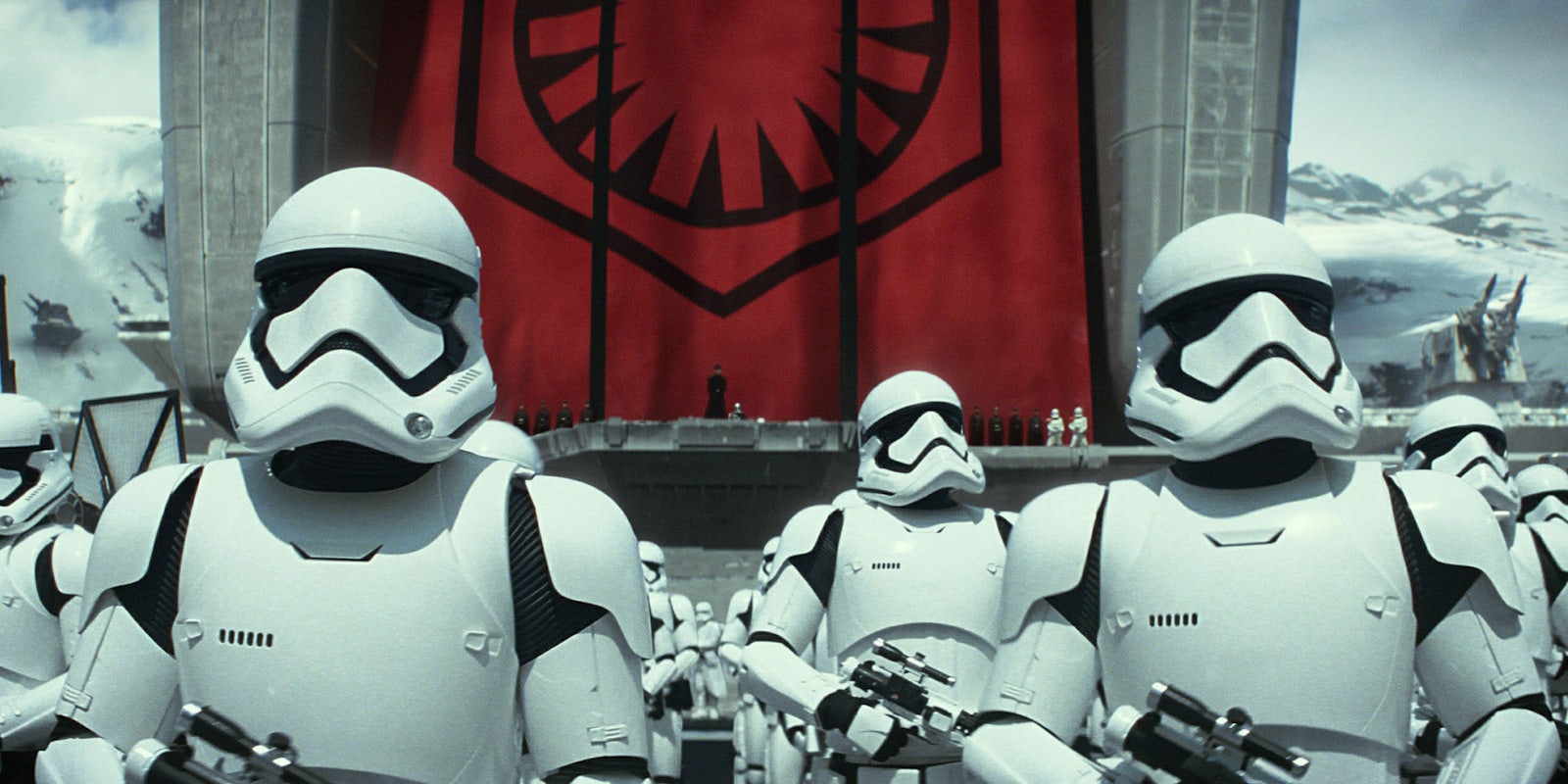Stormtroopers aren’t scary. En masse, they represent the power of the Galactic Empire, offering ranks of gleaming white cannon fodder to overwhelm the enemy through sheer force of numbers. But on an individual basis, they’re comically useless. Portrayed without names, faces, or any sign of independent thought, the most famous Star Wars soldiers are easily taken out by a single blaster bolt.
Despite their often slapstick role during fight scenes, stormtroopers are an effective symbol of authoritarian violence: an image of rigid conformity, with a shared identity forged in propaganda and fear. Stormtroopers live under constant surveillance, facing punishment for any expression of individuality.
You can’t discuss stormtroopers without digging into this political subtext, which makes their popularity doubly intriguing. In other fandoms, dressing up as the fascistic villains would earn you the side-eye. Getting a Dark Mark tattoo because you love Harry Potter? Yikes. Wearing a Hydra T-shirt as a Marvel fan? That literally happened at a neo-Nazi rally last year. But even the most progressive of Star Wars fans seem chill with stormtrooper merch and costumes. In fact, stormtrooper cosplayers are famous for their charity work, organized through an international fan club called the 501st Legion.
WATCH: The Hidden Genius of Stormtrooper Costume Design
Despite being both evil and incompetent, stormtroopers have become a beloved icon. Their design is so brilliant, so instantly memorable, that it’s now as recognizable as Mickey Mouse or the Superman logo. With help from a Star Wars costume designer and some experts in the field, we decided to find out why.
Stormtroopers: A history
The original stormtroopers began with concept artist Ralph McQuarrie—the man responsible for much of Star Wars’ aesthetic—and costume designer John Mollo. Named after the Nazi Sturmabteilung shock troops and their German predecessors in World War I, their armor combines threatening imagery like skulls, Nazi helmets, and a fishlike downturned mouth. As Rogue One and Solo: A Star Wars Story costume designer Glyn Dillon tells the Daily Dot via email, they’re a defining image for a generation of fans:
“I was six years old when I first saw them. I’d never seen anything like them. Are they robots? Are they soldiers in suits? I didn’t know, but I knew I instantly loved them. Before I got to see the film, my brother had bought me the paperback novelisation, which had in its centre a few glossy pages of photos and film stills. These alone were enough to blow my mind. One of the main images, burnt into my retina from that book, was a stormtrooper sat astride a Dewback. It didn’t look like Science Fiction I’d seen before… it wasn’t silver and shiny… I can’t really explain just how earth-shattering it was for me.”
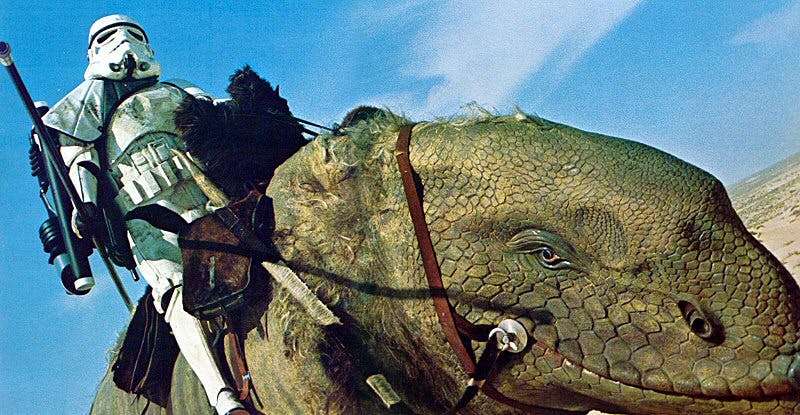
One can’t underestimate the importance of visual worldbuilding in Star Wars. So many memorable elements—stormtroopers, lightsabers, Darth Maul—succeed simply because they look cool. And when it comes to canonical detail, we learn more about the Empire from costumes and production design than we do from the actual text of the films.
“I have always viewed the [stormtrooper] uniform, in its most primitive form, as skeletal,” Fashion in Film author Christopher Laverty says. “The stark white armor contrasting with the black under-suit gives stormtroopers a bony appearance, their face-plate akin to the skull on a Jolly Roger pirate flag. Put simply, stormtroopers are supposed to be intimidating and evoking death.”
Laverty points out that in the visual language of Westerns (one of Star Wars’ key influences), heroes traditionally wear white hats and villains wear black. The Empire’s white-clad soldiers flip the script, hinting that they don’t view themselves as the bad guys. They’re trying to save the galaxy from chaos and impurity, after all, and there’s nothing cleaner than that shiny white armor. In the color palette of Star Wars, the good guys are more likely to wear colors and fabrics that reflect the natural world, contrasting with the sterility of the Empire. Even the building materials are symbolic, with Finn swapping polyester resin armor for Poe Dameron’s buttery leather jacket in The Force Awakens.
Built from a durable “plastoid” substance over a black body-stocking, the traditional stormtrooper armor is emphatically one-size-fits-all, falling in line with the Empire and First Order’s vision for a human-supremacist galaxy. While the Rebels are a motley crew of alien races, Imperial soldiers are (we assume) all human, even sharing a similar physical build.
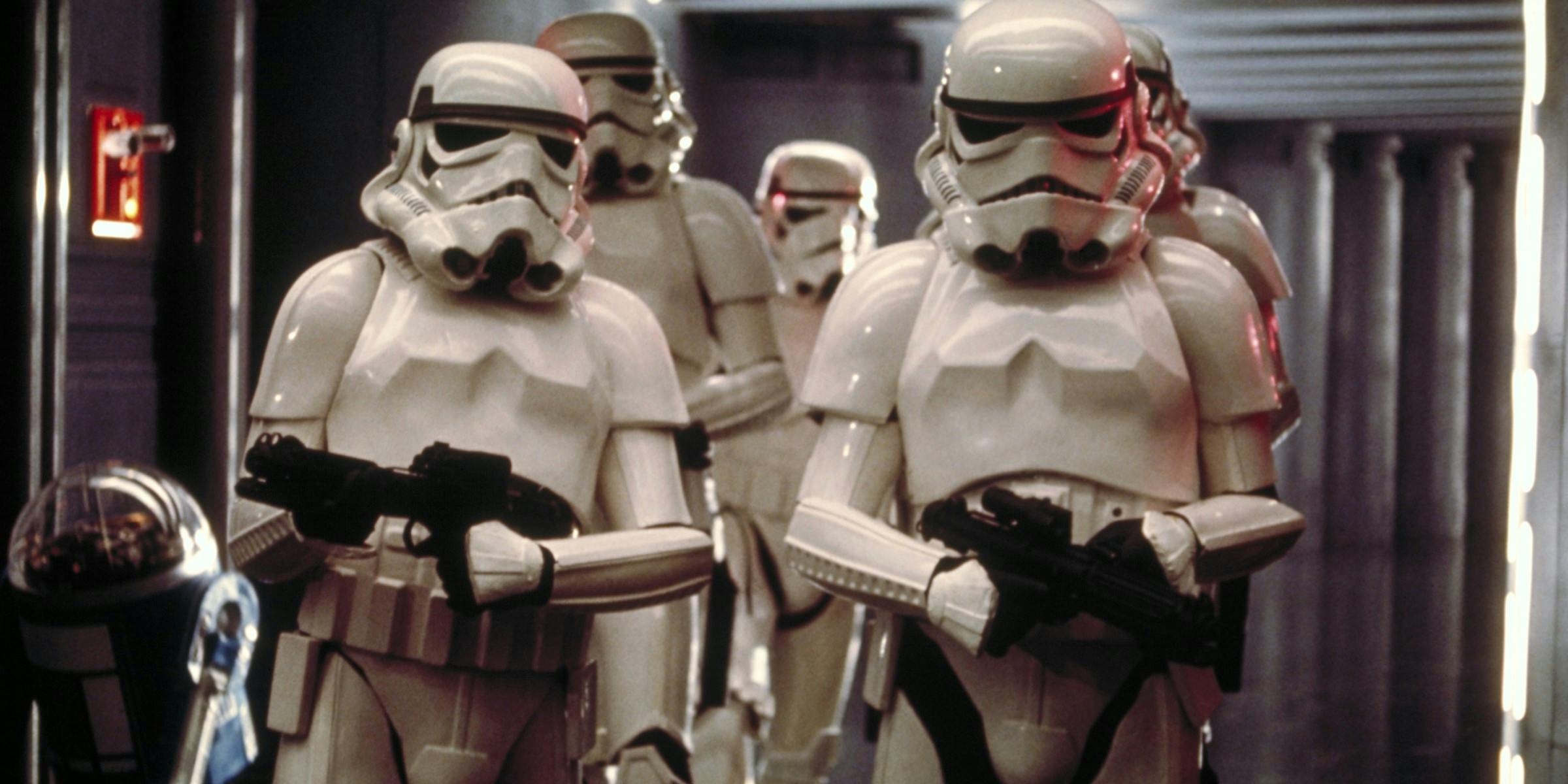
“While plastic might not seem very protective in battle, it evokes modern or futuristic design,” explains Saul Drake, project director of the Smithsonian’s Star Wars costume exhibit. Plastic both looks and sounds different from the metallic clank of historical armor, creating the image of an army of molded action figures: “identical, interchangeable, and unlimited in quantity.”
Much of the stormtroopers’ appeal lies in their mystique. “It’s almost a paradox,” says Laverty. “The suit is inherently cool because it allows us, perhaps forces us, to project. All we have to go on is a reflective visor and the raspy, disembodied voice of the wearer.” That visor makes them easy to dehumanize, which has a handy side-effect for Star Wars’ role as a children’s movie. Since they’re portrayed as a disposable force of anonymous goons, we don’t have to feel bad when the good guys kill a stormtrooper.
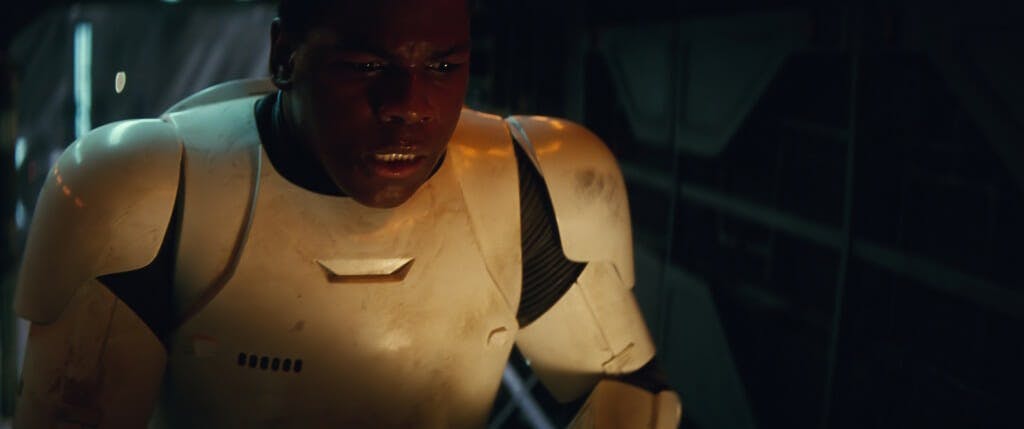
Thirty-five years into the franchise, The Force Awakens finally revealed what was under the mask. Finn gave a human face to the stormtrooper army, introducing a new moral dilemma to the story. If Finn is a relatable human with hopes and fears and moral qualms, could other troopers be the same? Finn didn’t volunteer to join the First Order; he was kidnapped as a child and brainwashed into a life of authoritarian conformity. These are the people the Resistance must kill in order to survive.
Arriving back from his first mission, traumatized and panicked by his failure to fire on the enemy, Finn pulls off his helmet. He’s immediately penalized by Captain Phasma, revealing two key details about life as a stormtrooper: You’re expected to keep your helmet on at all times, and your gun is fitted with a tracking device. By contrast, the heroes of the Rebellion and Resistance display a vibrant range of personalized fashion choices, from Luke Skywalker’s poncho collection to the mystical jewelry of The Last Jedi.
We never see the inside of a stormtrooper helmet, but the Lucasfilm prop makers are nothing if not detail-oriented. There’s an official design for the helmet’s interior, featuring voice filters, air filters, temperature control, power cells, and headphones. The mask’s blank black eyes are just for show: an opaque shell covering a holographic display, cutting the wearer off from the outside world. So while the Rebels can hug each other and feel the sensation of rain and wind on their skin, the stormtroopers live behind an impermeable barrier of technology, surgically separated from the Living Force. They don’t even breathe the same air as everyone else.
We can track the Star Wars timeline through the evolution of stormtrooper armor. Absent from The Phantom Menace, its origins date back to the clone army in Episode II. Their first uniforms resemble the Mandalorian armor worn by the clones’ progenitor Jango Fett, lacking the menacing imagery of the Original Trilogy troopers. Wearing bright colors and cylindrical helmets, this army still works for the Jedi. Only after Palpatine’s takeover do the iconic white stormtroopers arrive, with conscripts replacing the clones after Episode III. By The Force Awakens 30 years later, the First Order has adopted the Imperial fleet’s surviving infrastructure, with Finn’s generation wearing a sleek, Apple-inspired update of the old white armor. This smooth change of leadership highlights the army’s lack of free will. The stormtroopers continue their routine after the fall of the Empire, easily co-opted by a new leader.
Inside the creative process for a new stormtrooper
Recent movies introduced new additions to the ranks, catering to different locations and missions. After working in the costume department for The Force Awakens, Glyn Dillon and David Crossman became the lead costume designers for Rogue One and Solo: A Star Wars Story, an epic task that involved creating new Imperial soldiers alongside the outfits for characters like Lando Calrissian and Jyn Erso.
“In the same way that the Nazis in WWII had uniforms that were intimidating and all about power, the Imperials have a very strong identity,” Dillon says via email. “All good costumes help to serve the story, and the hard surfaces, hard lines and strong silhouettes all tell the story of a grand mechanised, evil Empire, at the peak of its power.” This was the starting point for Dillon and Crossman’s new Imperial designs, like the elite Death Troopers in Rogue One.
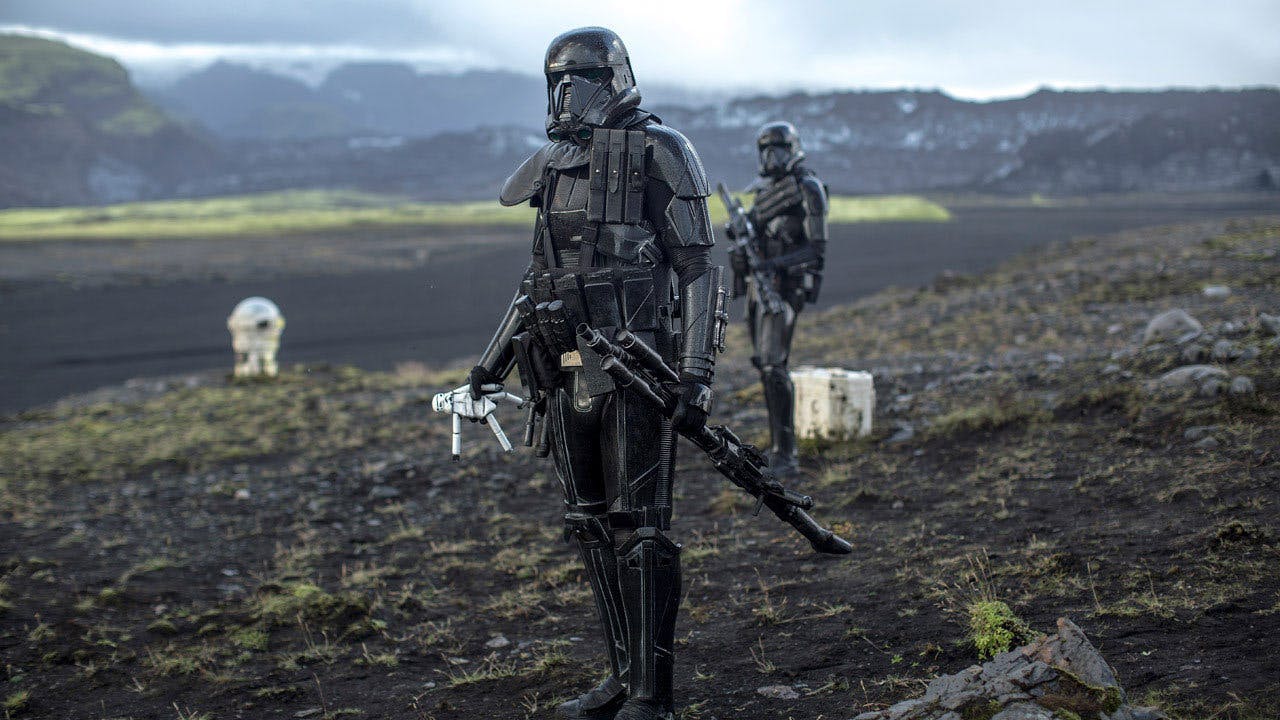
“The Death Troopers came about because [director Gareth Edwards] wanted something more menacing for the opening sequence of the film,” Dillon says. “The standard stormtrooper, even though it looks so cool, has kinda got himself a reputation for a certain ineptitude, an almost ‘Keystone Cops’ level of proficiency. Gareth wanted something that would feel scary and dangerous… and also to see something unfamiliar, yet familiar. There was a particular Ralph McQuarrie painting where the stormtrooper looked very lean, like it could even be a robot, rather than a man in armour.
“The idea was to go much less bulky than the Force Awakens First Order troopers. I was really happy with that direction because a scrawny guy with a figure more like a climber than a gym bunny feels tougher to me. The Rambo look always felt a bit over the top. Anyway, the best way to achieve that look was to have really tall, skinny guys to be the Death Troopers, so we designed the costume around this brilliant Bulgarian, Radistan Cholakov, who was our perfect 6’5” specimen.”
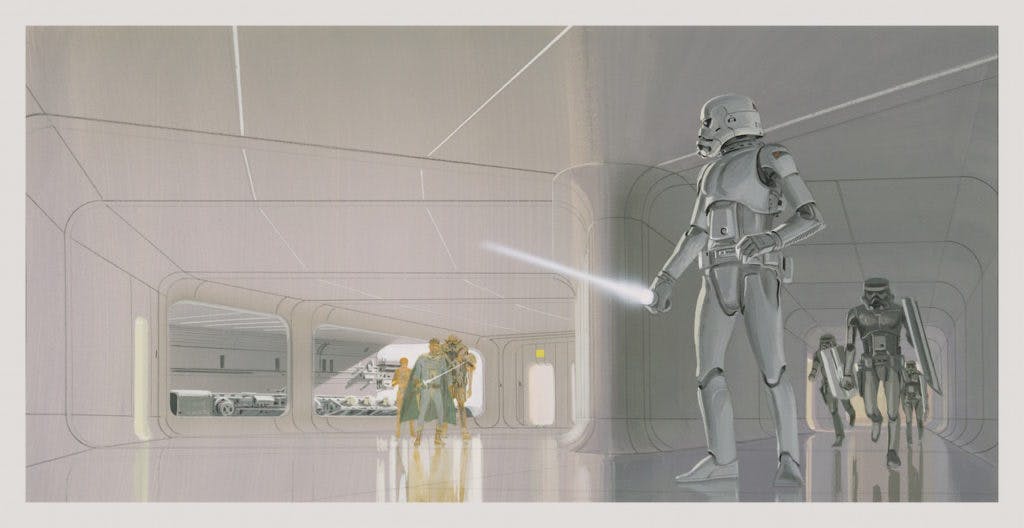
The process for designing a new stormtrooper is fascinatingly complex. When creating something like the mud-spattered trench infantry in Solo, there are numerous factors to consider. What terrain are they designed for? Should they resemble something from the real world? What emotion should they inspire from the audience? Will they work as an action figure?
“The trench troopers were basically OT troopers but we wanted to add something other than buckets of mud,” Dillon explains. “Dave Crossman, like John Mollo, is a military expert. Due to the WWI inspiration for the setting of [the planet] Mimbam, we thought it would be cool if they had a version of the brow plate (sometimes referred to as a sniper plate) that fitted to the classic M16 german infantry helmet.”
Another of Solo’s new designs, the frontier rangers, were inspired by brutalist architecture to handle harsh weather during the mountain train robbery scene. Dillon envisioned them like a snow plow or ice breaker, with bulky magnetic boots suggested by former Solo directors Phil Lord and Chris Miller. The next step was a physical prototype built by Rob Matthews at the film’s workshop, illustrating how the design would function in real life. The end result was a suit of armor involving articulated boots made from over 80 separate pieces, with visual effects including smoke and lights.
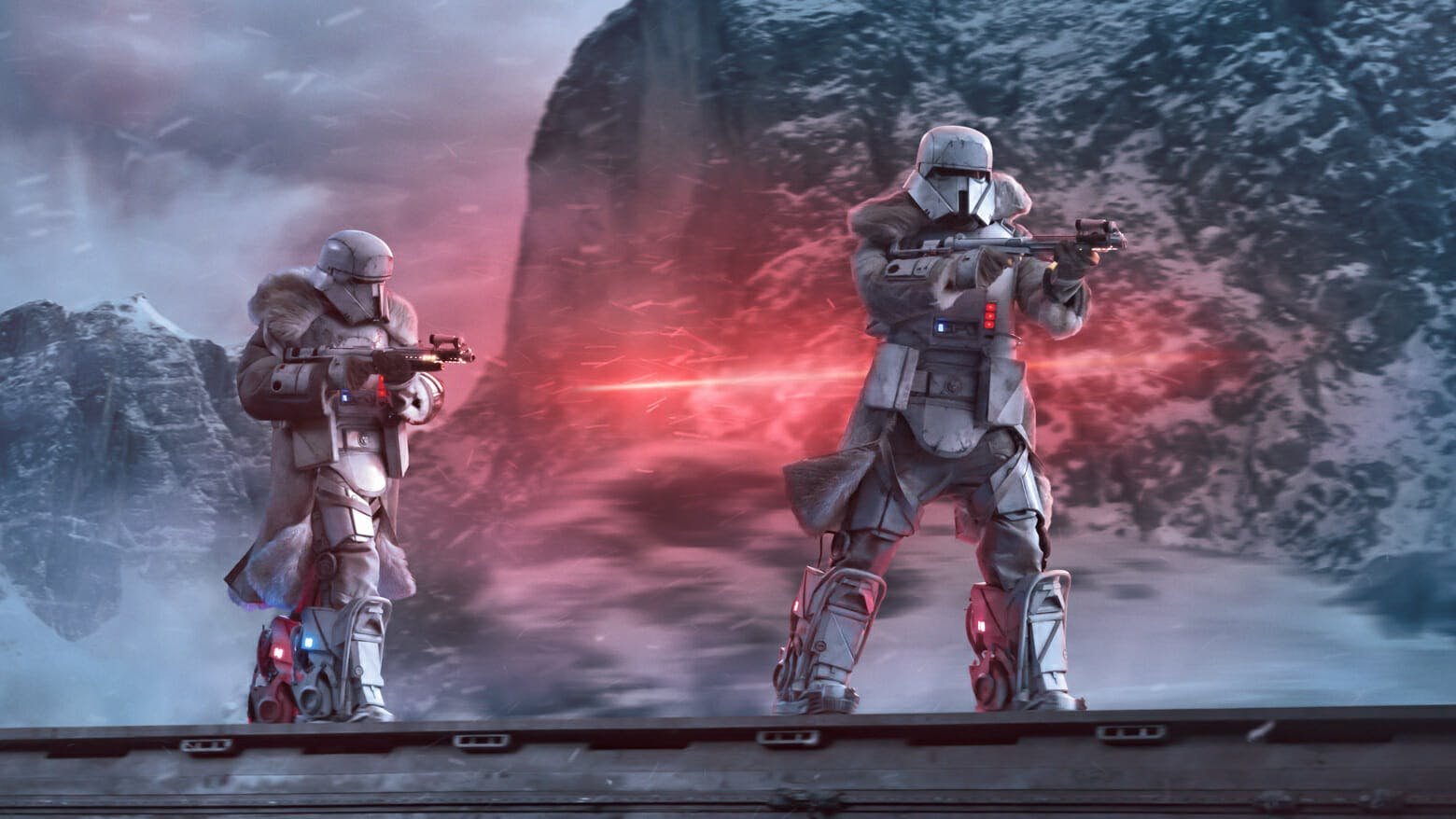
Of course, there’s one final factor that should never be overlooked: Does it look cool?
For Rogue One, Dillon and Crossman worked on so many trooper redesigns that some ran the risk of being abandoned. One example was the tank pilots in the Holy City of Jedha, whose helmets were actually an early Death Trooper design.
“We got as far as sculpting one in ZBrush with the excellent modeller Sam Williams and printing it out. But we moved away from that design quite quickly. The helmet sat in our design room for quite a long time and Gareth would occasionally say, ‘Yeah yeah, we’ll fit it in somewhere, I promise!’ When the idea for the tank in Jedha came up, I knew we had our tank commander and we worked it up into a full costume. A week or two later George Lucas came to visit the production, Gareth was taking him on a tour of all the departments and when he visited our design room, the first thing George said was ‘That’s a cool helmet!’ as he pointed at the Tank trooper on the table. So I like to think of that as getting the famous George Lucas ‘fabuloso’ stamp of approval.”
The politics behind the stormtrooper army
With its background in Nazi imagery, stormtrooper armor has always had a rich political subtext. To find out more about the psychological basis for the Empire’s uniform choices, we spoke to cultural historian Katherine Lennard, an expert in the uniforms of extremist organizations like the KKK.
“Wearing a uniform suggests the wearer’s commitment to the organization, and ostensibly its principles—even if an individual’s views don’t conform to the group’s principles as uniformly as his clothes might suggest,” Lennard says. “Masks are particularly helpful in this regard because they further conceal the identifying features of individuals, and instead present an uninterrupted image of uniformity. This kind of sameness is a key way of gaining power for organizations like the Klan. Certainly, weapons help, but uniforms weaponize individuals’ bodies by transforming them into a single uniform whole.”
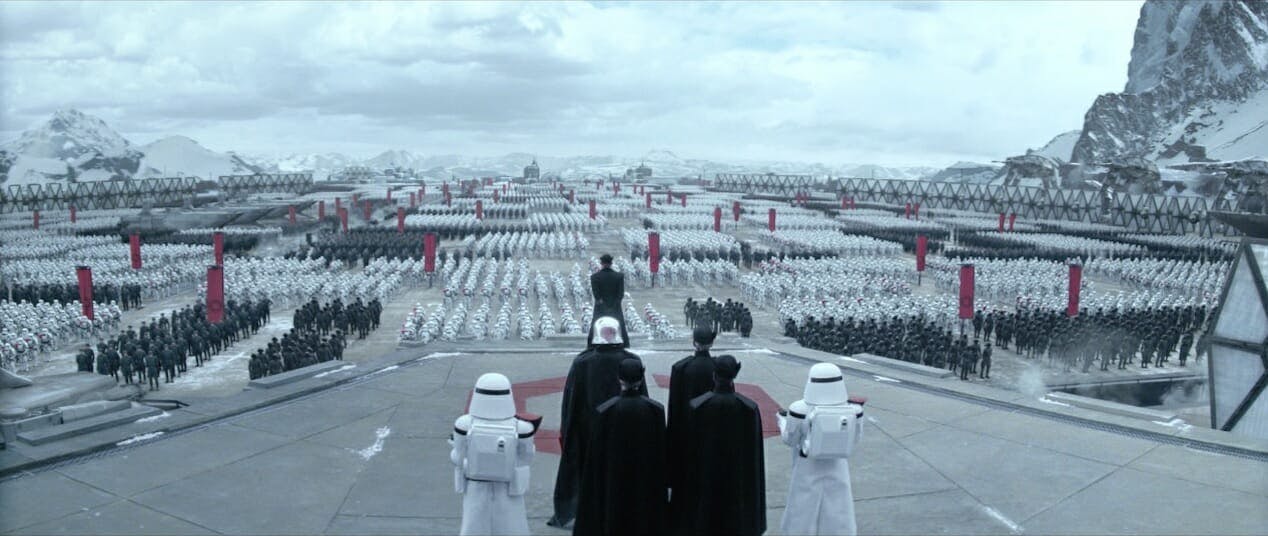
It’s a classic example of authoritarian propaganda: If everything looks clean and shiny and organized, then hopefully you’ll believe the Empire offers a more secure way of life. “The glossy surfaces of stormtrooper armor, and the apparent mass-production of these garments, suggest a powerful organization with the economic means to produce and issue uniforms on a grand scale,” Lennard says.
You can see why this might be an appealing prospect for kids growing up on chaotic Outer Rim planets, like Luke’s childhood friend who joined the Imperial Navy.
The Empire’s Nazi inspirations are especially obvious with officers like General Hux, and Lennard explains there are deeper historical callbacks as well. One overarching theme is a resemblance to “the clean lines and fundamental principles of modernism,” which overlapped with mid-20th century fascist design. “The goal of modernist design was to reimagine the world through an aesthetic transformation,” Lennard explains—an idea that fits with the Empire’s mechanized overhaul of the galaxy, building Death Stars and planting military bases in the middle of forests.
“Modernists rejected highly ornamented and ornate late-19th century architecture, fashion, and other decorative arts, favoring instead a more stark and graphic visual style,” she adds. “This fit well with social and political movements that attempted to cleanse society of dissident thought in favor of dictatorial political control.” That’s an intriguing way to look at the transition from Naboo’s graceful organic beauty in The Phantom Menace, to the harsher aesthetic of the Empire 20 years later.
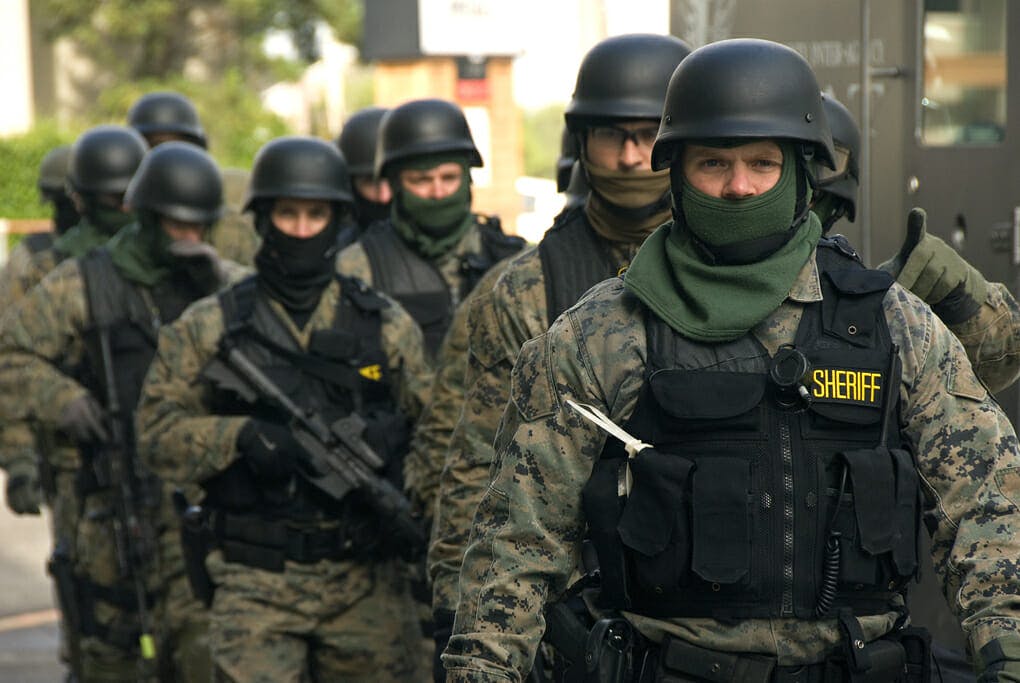
We refer to stormtroopers as an army, but they’re equally likely to be cops. The Empire is a dystopian police state, in a way that feels more true to life now than it did in the 1970s. In Star Wars there’s no visual distinction between shock troops and law enforcement, and in the real world, this overlap has a proven psychological effect. People respond very differently to a cop wearing a blazer and a cop wearing full body armor, and the officers will consider their surroundings differently as well. If you’re dressed like you’re going into a war zone, that’s what you’ll expect to face. In fact, experts believe there’s a direct link between militarized police uniforms and a rise in aggressive police behavior and brutality.
Wearing body armor and an identity-obscuring helmet puts you in the right mindset to expect an enemy attack—although fortunately, this hasn’t carried over to real-life cosplayers.
Stormtrooper fandom and the 501st
Stormtroopers are a ubiquitous presence at sci-fi conventions, formalized through a semi-official fan club called the 501st Legion. It hosts meetups and charity events where fans dress up in meticulously accurate replica uniforms. If you’ve ever seen stormtroopers marching in a parade, visiting kids at a hospital, or walking the red carpet at a Star Wars premiere, you probably saw a local garrison of the 501st in action.
Eric Brager joined the 501st in 2011 and is now the executive officer of the New England Garrison. He owns several replica costumes including Darth Vader, and he understands the organization as well as anyone.
“Most of us, including myself, I don’t really consider myself a cosplayer,” he says. “I don’t even like Halloween or any other kind of costume. But we have this idea where we wanna be this kind of life-size action figure.” It fits, then, that Brager’s favorite part of being a 501st member is attending charity events like the Make-a-Wish Foundation or marching in Pride parades.
The 501st Legion boasts over 13,000 members worldwide, but its membership numbers are even more impressive when you know about the entry requirements. You can’t just half-ass your costume; it has to fulfill enough regulations to satisfy Captain Phasma. Local chapters host armor-building parties and members have access to a terrifyingly detailed reference library for every possible permutation of costume. Once you’re finished, local and regional officers compare your armor to reference photos and either approve them or ask you to make corrections. (As you might expect, there are often disputes about accuracy.)
Brager says that while there used to be “a lot of shame” about buying costumes off the shelf rather than crafting them yourself, there’s less stigma nowadays. It’s still an expensive hobby, though. If you want a movie-accurate replica from the official retailer Anovos, it’ll set you back almost $2,000. Brager estimated that of the 150 people in his local chapter, about a third bought their costumes online.
That’s because when it comes to the costumes, the 501st appeals to a very specific kind of person: detail-oriented perfectionists.
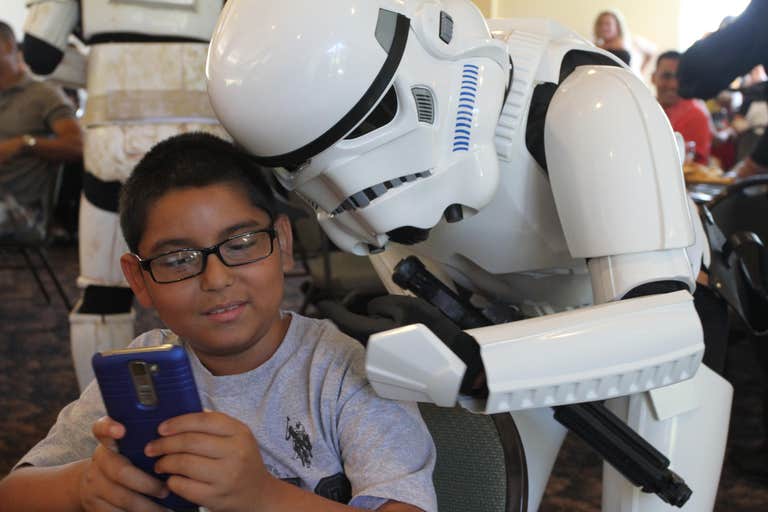
“We care about accuracy and we care about bringing what you saw on-screen to life. There’s really no room for expression,” Brager explains. “The Mandalorian Mercs [another popular Star Wars cosplay club] have a lot of freedom and they do crazy stuff with their costumes. We do not encourage that at all. Accuracy, for good or for bad, is really what we’re about.”
This kind of precision is the polar opposite of transformative fan culture, where people use fanfic and art to remix the source material. Yet in its own way, the 501st does make one significant change to the canon. Its members enjoy detailed accuracy in the same way that some people build model trains or historical dioramas, but they don’t condone the ethos of the Empire. They relate to its appeal on an aesthetic level, stripped of its political connotations and rebooted under the motto “Bad Guys Doing Good.”
As any 6-year-old will tell you, stormtroopers look cool as hell. They’re Brager’s most influential memory from seeing the first movie as a child, and he admits that “there’s something really attractive about this evil force that travels around in this very clean, orderly way.”
Within the Star Wars universe, stormtroopers are walking propaganda for the Empire, presenting an image of organized strength and purity. Of course, this backfires because stormtroopers are famously incompetent, which in turn takes the sting out of their fascist symbolism. They illustrate the false promise that authoritarian regimes will make the trains run on time. In reality, what you’re getting are spiffily dressed mall cops with delusions of grandeur.
“They never hit anything, they hit their head on things… it’s absolute slapstick comedy,” Brager says. “While I certainly didn’t recognize it as a kid, it allowed me to be a lot sillier in a stormtrooper costume, knowing they are kind of the butt of the Star Wars movies’ jokes.”

